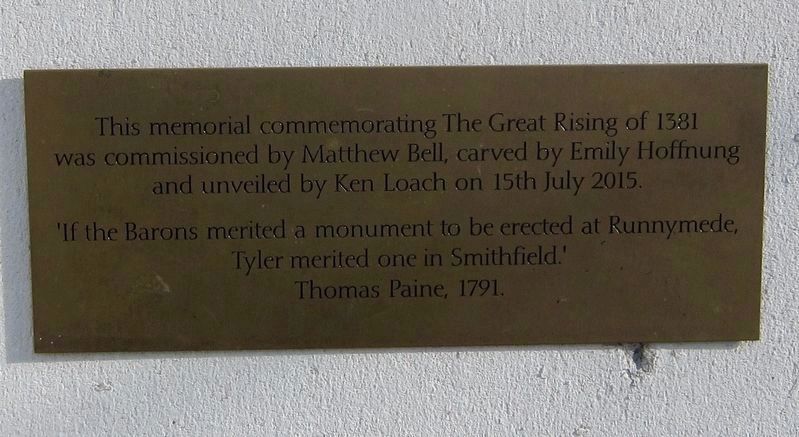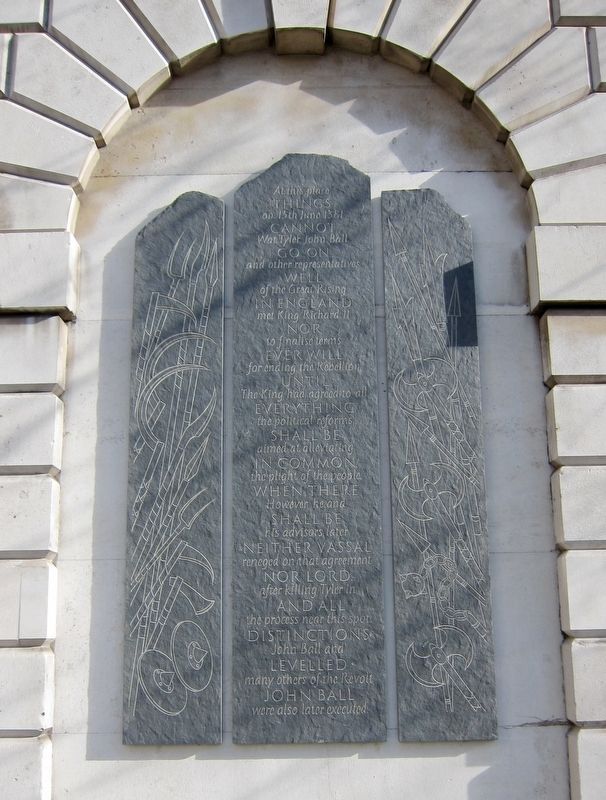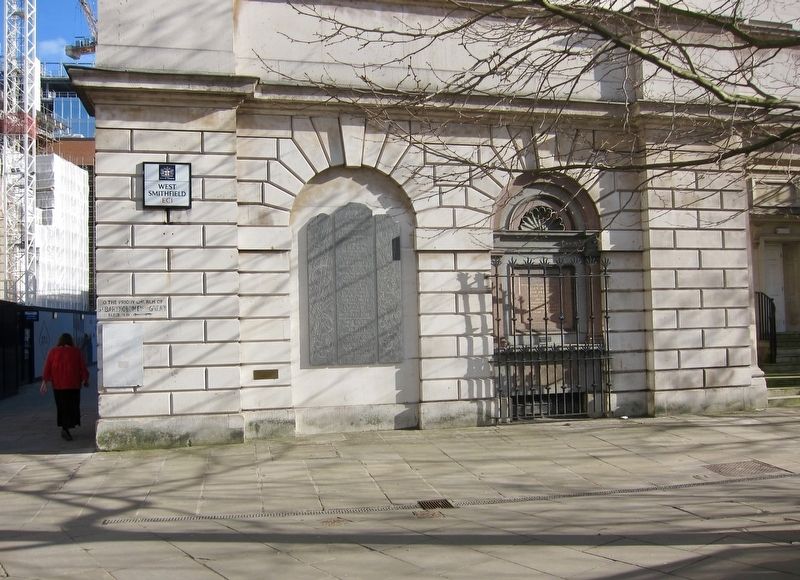City of London in Greater London, England, United Kingdom — Northwestern Europe (the British Isles)
Great Rising of 1381 Memorial
At this place
THINGS
on 15th June 1381
CANNOT
Wat Tyler, John Ball
GO ON
and other representatives
WELL
of the Great Rising.
IN ENGLAND
met King Richard II
NOR
to finalise terms
EVER WELL
for ending the Rebellion.
UNTIL
The King had agreed to all
EVERYTHING
the political reforms
SHALL BE
aimed at alleviating
IN COMMON
the plight of the people.
WHEN THERE
However he and
SHALL BE
his advisors later
NEITHER VASSAL
reneged on that agreement
NOR LORD,
after killing Tyler in
AND ALL
the process near this spot.
DISTINCTIONS
John Ball and
LEVELLED.
many others of the Revolt
JOHN BALL
were also later executed.
Erected 2015 by Matthew Bell.
Topics. This historical marker and memorial is listed in this topic list: Civil Rights. A significant historical date for this entry is June 15, 1381.
Location. 51° 31.104′ N, 0° 6.017′ W. Marker is in City of London, England, in Greater London. Marker is at the intersection of West Smithfield and Little Britain on West Smithfield. Touch for map. Marker is at or near this postal address: 57A West Smithfield, City of London, England EC1A 9DS, United Kingdom. Touch for directions.
Other nearby markers. At least 8 other markers are within walking distance of this marker. Marian Martyrs (here, next to this marker); To The Immortal Memory of Sir William Wallace (a few steps from this marker); St. Bartholomew World War I Memorial (a few steps from this marker); William Wallace (within shouting distance of this marker); The Golden Boy of Pye Corner (about 150 meters away, measured in a direct line); Charles Lamb (about 210 meters away); John Bray's House (about 210 meters away); The Royal Fusiliers (about 240 meters away). Touch for a list and map of all markers in City of London.
Regarding Great Rising of 1381 Memorial. Comprehension of the memorial is easier if one literally reads between the lines, as two texts are interwoven.
The text in capitals is a quote from John Ball, "Things cannot go on well in England nor ever well until everything shall be in common when there shall be neither vassal nor Lord, and all distinctions levelled".
The lowercase text tells of the Great Rising, reading: "At this place on 15th June 1381 Wat Tyler, John Ball and other representatives of the Great Rising met King Richard II to finalise terms for ending the Rebellion. The King had agreed to all the political reforms aimed at alleviating the plight of the people. However he and his advisors later reneged on that agreement, after killing
Tyler in the process near this spot. John Ball and many others of the Revolt were also later executed".
Also see . . . Peasants' Revolt (Wikipedia). "The Peasants' Revolt, also called Wat Tyler's Rebellion or the Great Rising, was a major uprising across large parts of England in 1381. The revolt had various causes, including the socio-economic and political tensions generated by the Black Death in the 1340s, the high taxes resulting from the conflict with France during the Hundred Years' War, and instability within the local leadership of London. The final trigger for the revolt was the intervention of a royal official, John Bampton, in Essex on 30 May 1381. His attempts to collect unpaid poll taxes in Brentwood ended in a violent confrontation, which rapidly spread across the south-east of the country. A wide spectrum of rural society, including many local artisans and village officials, rose up in protest, burning court records and opening the local gaols. The rebels sought a reduction in taxation, an end to the system of unfree labour known as serfdom and the removal of the King's senior officials and law courts." (Submitted on May 7, 2018.)
Additional keywords. Smithfield

Photographed By Andrew Ruppenstein, March 20, 2018
3. Great Rising of 1381 Memorial Information Plaque
This memorial commemorating The Great Rising of 1381 was commissioned by Matthew Bell, carved by Emily Hoffnung and unveiled by Ken Loach on 15th July 2015.
'If the Barons merited a monument to be erected at Runnymede, Tyler merited one in Smithfield.' Thomas Paine, 1791
Credits. This page was last revised on January 27, 2022. It was originally submitted on May 7, 2018, by Andrew Ruppenstein of Lamorinda, California. This page has been viewed 473 times since then and 67 times this year. Photos: 1, 2, 3. submitted on May 7, 2018, by Andrew Ruppenstein of Lamorinda, California.

